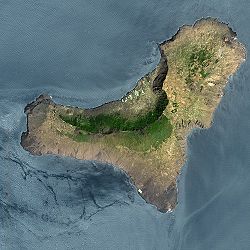This article needs additional citations for verification .(April 2025) |
 Painting of Bimbache by Leonardo Torriani, 1592 | |
| Total population | |
|---|---|
| Unknown | |
| Regions with significant populations | |
| Religion | |
| Animism | |
| Related ethnic groups | |
| Berber · Riffian · Guanches |
Bimbache or Bimbape is the name given to the inhabitants of El Hierro, who inhabited the island before the Spanish conquest of the Canary Islands that took place between 1402 and 1496. The Bimbache are one of several peoples native to the Canaries, with a genetic and cultural link to the Berber people of North Africa. The Bimbache people shared a common link with other aboriginal peoples of the Canary Islands.
Contents
- Division of aboriginal territory
- Spanish conquest and the Bimbache
- Bimbache mythology
- Genetics
- See also
- References
- Sources
- External links
The island of El Hierro was known to the Bimbache as Eseró or Heró. The word "Bimbache" means "Sons of the Sons of Tenerife", so were believed to be descendants of the Guanches, the ancient inhabitants of the island of Tenerife.


